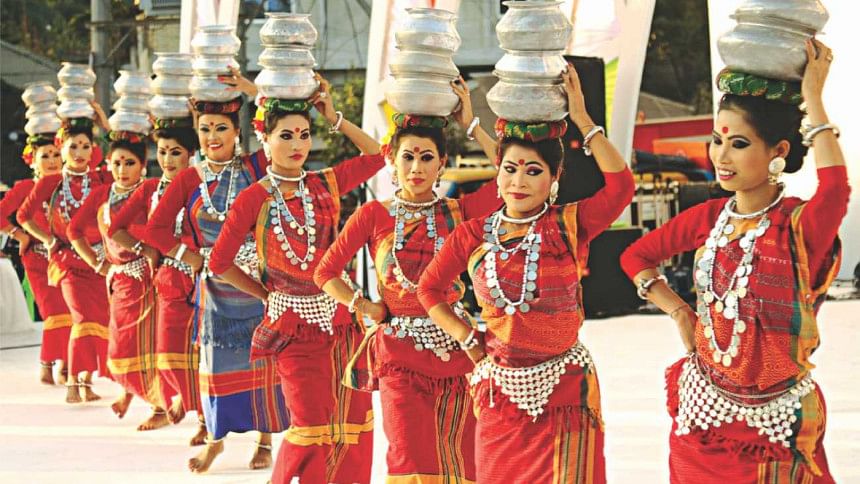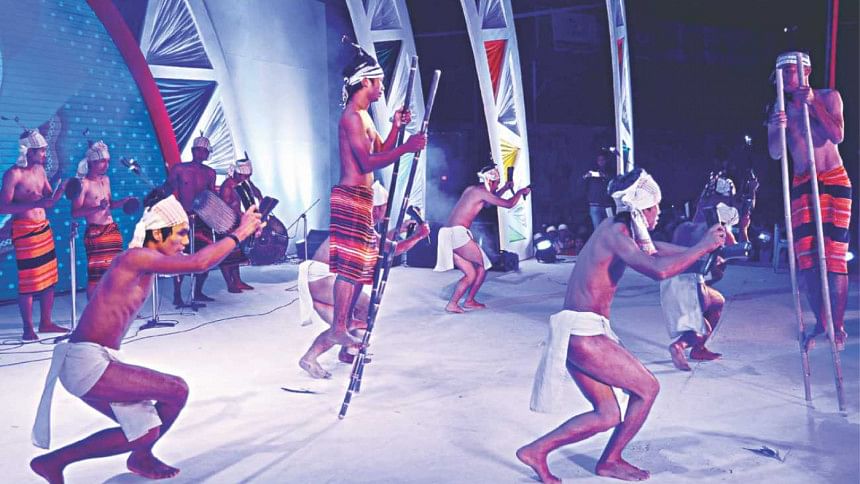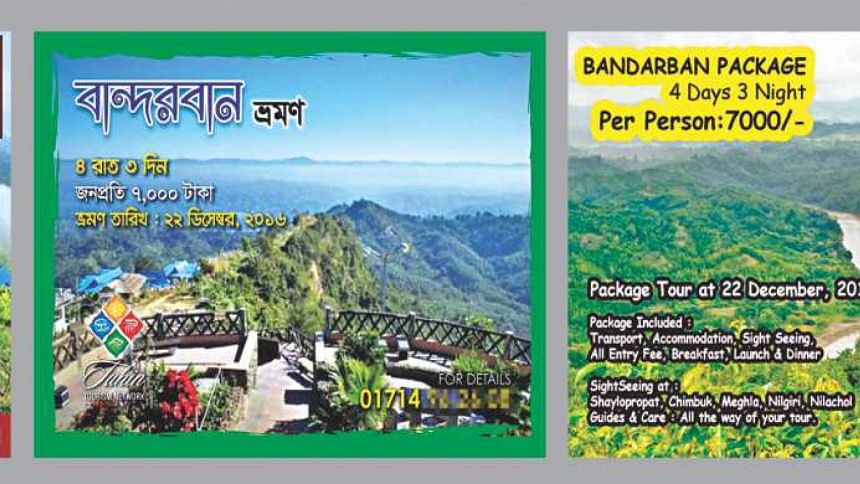THE BENGALI GAZE

A TV commercial by a prominent telecom company was brought to my attention through a Facebook post by a journalist. The scene begins with two young men making their way through a water body on a bamboo raft in an exotic location somewhere in the Chittagong Hill Tracts. Next, they are seen making their way up a mountain through a vast green landscape far from any sign of human life. One of the men expresses his frustration at not being able to find what they were looking for. The other man smiles in response and points to an old man in a bamboo hut up in the mountain.
"He is going to get you a recharge?" the first man laughs skeptically. The men seem to have run out of balance on their phones and, given their remote location in the Hills, are concerned about not being able to top-up their phones.
The second man replies that he would at least like to try his luck. He goes up to an old Jumma man sitting outside the hut and shouts at him, "Uncle, can I flexi here? Can I recharge here? Taka! Taka! Phone! I want to talk! You know, taka! Recharge!"
The man is shouting out these requests while gesturing wildly with his arms. Both are doubtful about getting a response. How would an ordinary native man in the wilderness of the Hills understand the modern Bengali language or have access to the modern phone network! The second man turns around and looks at his friend in frustration and the old man suddenly surprises everyone and responds in Bangla, "How much money do you need?"
The two men are shocked and the second man delightedly shouts back again, "A hundred taka!"
The old man keys in the amount on his phone keyboard, the second man shouts out his gratitude and extends his hand towards the old man."You are my GP brother," he exclaims, "Come, let's take a selfie!"
And the commercial ends with information about the telecom company's wide network coverage – that every other person in Bangladesh owns a phone from that company.

The telecom in question is a multi-million-dollar industry and one can safely assume that the concepts used in their TV commercials are discussed and vetted at a very high level for what they will represent about their company. So, what does this TV commercial say and represent?
Stuart Hall, the late Jamaican-born cultural theorist and founding editor of the New Left Review argued that media representation has at least two meanings – the literal, denotative meaning and the thematic or connotative meaning.
The literal meaning from this TV commercial is that the telecom has such a wide network reach that even remote and backward areas in the Hills are covered under its network. The connotative meaning in the advertisement is that the adivasis are simple, native, and backward folk, but despite that, a modern product and service have reached their lives. The telecom company has made a modern man out of the backward native. The two men in the commercial are also delighted with this reach, and gaze in wonder as the native, is seen handling modern equipment and speaking the modern Bangla language out here in the middle of nowhere. Of course, this exciting and novel encounter can only be complete once the spectacle is captured in a selfie and shared on Facebook.
Hall also argued that representation of the 'different' and the 'other' is a form of patronisation and that there is a secret fascination in this 'otherness'. In popular culture, this representation makes for stereotyping and creates a spectacle of the 'other'. The politics of this exhibitionism has consequences far beyond just the spectacle that this commercial produces for its viewers. In the case of the Jummas, it is a form of erasure of the history of state oppression, violence, land loss and recognition as equal citizens. On the one hand, it leads to celebration of adivasi cultural festivals, beauty contests, food festivals, promotion of ethnic tourism – all sponsored by big corporations, the military, and the state tourism board. On the other hand, the Hills, to this day, remains the place where delinquent government officers are posted as a form of punishment, Jummas living in the cities have to assure landlords they will not eat frogs and snakes, and adivasi women in universities have to accept catcalling and sexual harassment for having 'chinky eyes'. Negative stereotyping has real-life consequences for real-life people.
In addition to that, it facilitates erasure of the decades of state-led oppression of killings and rape in the Hills. It also helps to hide the present-day repressive conditions and normalises it for elite Bengalis. While the telecom advertisement gives an impression of a beautiful and serene atmosphere in the Hills where the young, urban, middle-class, adventure-seeking Bengaliscan go for a pleasure trips, the reality is that the Jumma people live under state surveillance and are still treated as the suspicious 'other'. In 2014, I went as part of a team who traveled to Babuchara to find out what had happened in a violent attack which led to 21 families losing their homes and were forced to take refuge in a school. There, I found that the local children had to go to school right past armed border guards. Everyday freedom of movement is greatly inhibited by the presence of extra security forces. Jumma activists are frequently stopped from holding protests and demonstrations, which are part of the democratic rights of citizens. Random arrests and house searches of Jumma people's homes never reach mainstream media. There is no justice for Jumma women who get raped in the CHT.
Difference matters because what something is not is more important than what it is. Jumma is different and exotic because Jumma is not Bengali. While working as coordinator of the CHT Commission, I once led a group of journalists into the CHT to visit and report on various areas where Jummas had been attacked. For one of the young male journalists, this was clearly more than just a journalistic venture. In the car he talked about how cool it would be to have a Marma girlfriend. It did not stop there. While visiting a Mro village in Bandarban, he made a Mro girl put a flower garland around his neck and take pictures of a mock wedding ceremony. That same day we visited an area where a Jumma woman had been raped and Hill Women's Federation were mobilising demonstrations against it. The two incidents -- the rape and the exoticisation – are not disconnected. Media's reinforcement of negative images reduces adivasis to objects in the hegemonic Bengali gaze.

Both Stuart Hall and writer Frantz Fanon have talked about how white people seem to be obsessed with the sexuality of black people. This is true for any minority population whose physical appearance is significantly different from that of the majority. The Channel I Parbotyo Lokoj Mela posters, for example, explicitly promotes tourism in the Hills – a beautiful young Jumma woman is usually the poster girl on the back-drop of a beautiful hilly landscape – both presented as the exotic 'other' for Bengali consumption. Otherness is always a compelling object of representation. Both the hills and the Jummas are different and exotic, and the representation of this difference is directly linked to questions of power. The Bengali elite is well aware of their superior position in the social hierarchy.
While tourism might seem like an innocent act per se, because of the poetics, politics and history of the Hills, this is far from the case. This history is at risk of being erased. The history of the Hills is that of loss of land to Dams, militarisation, the Forest Department and illegal settlement. It is a history of death and killings that is yet to receive any form of acknowledgement and recognition. And while the Hills are marketed as a paradise for young, adventurous upwardly-mobile Bengali tourists, it does not talk about the restrictions and discriminations faced by the Jummas. As recently as two years ago, the state decided that it would not allow Jummas to talk to outsiders without the presence of government officials (CHT Commission statement, 15 Feb 2015). It was quickly rescinded after protest from activists.
Much of the tourism itself is controlled by the state where Jummas are allowed to also own a few guest houses. The main function of the Jummas is to act as exhibitions for the Bengalis' entertainment. In Sajek, an 'innovative' tourist act was to throw candy from fast-moving vehicles while Jumma children scrambled to grab these handouts. An innocent Jumma child had to be crushed under the wheels of a tourist vehicle before the act was prohibited (CHT Observer, Feb 18, 2016). Connectivity and tourism lead to exploitation of the Hills and corruption; media giants, commercial sectors, NGOs, and the state are complicit in these exploitative activities. While things like the TV telecom ad, Parbotyo Lokoj Mela and the various other cultural activities in the Hills are presented as an innocent promotion of Jumma culture, these acts are carefully ahistoricised and sanitised for Bengali elite consumption – so that we do not have to remember or think about the past and present state-violence in the Hills in the name of nationalism and securing of our sovereignty.
The writer is currently doing an MA in sociocultural anthropology at the University of Western Ontario and can be reached at [email protected].
Reference
Hall, Stuart. 1997. The Spectacle of the 'Other'. Representation: Cultural Representations and Signifying Practices. The Open University.

 For all latest news, follow The Daily Star's Google News channel.
For all latest news, follow The Daily Star's Google News channel. 



Comments